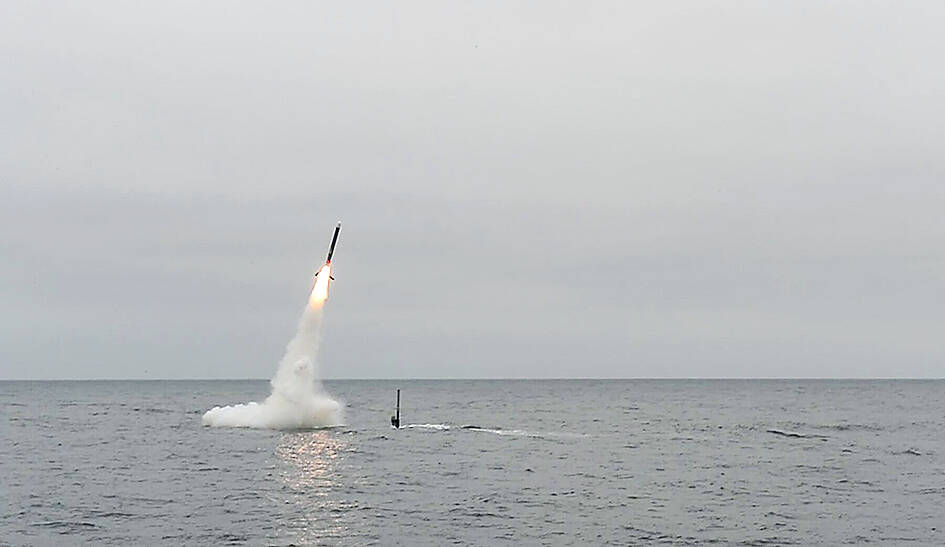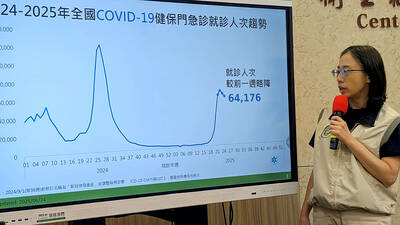The US Navy plans to begin arming submarines next year with ship-targeting versions of the widely used Tomahawk missile, part of Washington’s push to ramp up military capabilities to challenge Chinese maritime forces, particularly around Taiwan.
The “Maritime Strike” version of the Tomahawk, the RTX Corp. missile traditionally used as a ground-attack weapon, will be fielded after Oct. 1, program manager Captain Jon Hersey said in a statement. The latest models will be modified with a new guidance system enabling them to “to engage a mobile target at sea,” he said, adding the Navy took delivery of the initial version last year for tests before declaring it combat ready.
Fielding the new version of the Tomahawk — which made its battlefield debut in the early hours of the 1991 Persian Gulf War in Iraq —- would add to a growing US arsenal of ship-attack missiles to complement submarine-launched torpedoes intended to counter China’s numerically superior fleet. While the Navy also plans to start fielding the weapons on surface vessels, those are more vulnerable to China’s land- and sea-based anti-ship arsenal.

Photo : Grab from US Navy website
Taiwan, which China claims as its sovereign territory, is of particular interest for Washington and sees defending the island — and its crucial semiconductor industry — as a strategic, economic and political priority.
The schedule for the new maritime strike missile fits roughly within the Pentagon’s plans to field thousands of drones in the Indo-Pacific region to counter China, known as the Replicator program, which the Pentagon aims to deploy on a large scale between February and August 2025.
The development also comes alongside Washington’s burgeoning security alliance with the UK and Australia, known as Aukus. The trio on Friday announced a raft of plans, including the use of artificial intelligence aboard aircraft patrolling the Pacific to help track Chinese submarines.
The three powers said they would deploy advanced artificial intelligence algorithms on multiple systems, including the P-8A Poseidon aircraft to process data from each nation’s sonobuoys, underwater detection devices.
The missiles will be deployed on Los Angeles and Virginia-class submarines, which can carry as many as 12 land-attack Tomahawks, although some modified versions of the Virginia-class will be able to carry as many as 40.
The weapons have a range up to 1,000 miles (1,600 kilometers), according to Brent Sadler, a senior research fellow in naval warfare and advanced technology at the Heritage Foundation, as well as a former submariner and head of the Navy’s Asia-Pacific Advisory Group.
“The long range provides greater stand-off from Chinese anti-access and area-denial missile forces, and this would complicate Chinese planning for a blockade/invasion of Taiwan,” Sadler said in an email. “More work is needed to develop how these missile will be employed to overwhelm” China’s forces and take out enough ships to be “war-winning,” he said.
Japan may someday also deploy the new anti-ship version of the missile. The State Department notified Congress this month that Tokyo has been cleared to receive it first ground-attack Tomahawks in a sale valued at as much as $2.35 billion for up to 200 missiles.
“Should Japan also get this weapon, it adds another level of complexity the Chinese will have to contend with,” Sadler said.?
China has 370 ships and submarines in its naval force, including more than 140 major surface combatants, the Pentagon said in its latest assessment of Chinese military power. The US Navy has 291 deployable vessels.
China’s navy is largely composed of modern multi-mission ships and submarines, and it launched its third aircraft carrier last year, the CV-18 Fujian.
Vice Admiral William Houston, the Navy’s Submarine Forces Commander, said in a statement to Bloomberg News that he’s committed to fielding the Maritime Strike Tomahawk as quickly as possible but pointed out that “procurement, modernization and fielding schedules are dynamic and impacted by a variety of factors including industrial base and shipyard capacity.”
The US anti-ship arsenal now includes the ship-launched RTX SM-6 air defense missile adapted by the Pentagon’s Strategic Capabilities Office and Lockheed Martin Corp.’s Long Range Anti-Ship Missile. It can be launched from the Air Force B-1-B bomber and the Navy’s top aircraft carrier fighter, the F/A-18 E/F.
Separately, the Navy also fields Boeing Co.’s sea-skimming Harpoon anti-ship missiles, and Taiwan is buying at least 400 ground-launched versions for coastal defense. Those type of missiles figured prominently in a series of tabletop war games of a potential invasion of Taiwan by China conducted last year by the Center for Strategic and International Studies.

ECHOVIRUS 11: The rate of enterovirus infections in northern Taiwan increased last week, with a four-year-old girl developing acute flaccid paralysis, the CDC said Two imported cases of chikungunya fever were reported last week, raising the total this year to 13 cases — the most for the same period in 18 years, the Centers for Disease Control (CDC) said yesterday. The two cases were a Taiwanese and a foreign national who both arrived from Indonesia, CDC Epidemic Intelligence Center Deputy Director Lee Chia-lin (李佳琳) said. The 13 cases reported this year are the most for the same period since chikungunya was added to the list of notifiable communicable diseases in October 2007, she said, adding that all the cases this year were imported, including 11 from

Prosecutors in New Taipei City yesterday indicted 31 individuals affiliated with the Chinese Nationalist Party (KMT) for allegedly forging thousands of signatures in recall campaigns targeting three Democratic Progressive Party (DPP) lawmakers. The indictments stem from investigations launched earlier this year after DPP lawmakers Su Chiao-hui (蘇巧慧) and Lee Kuen-cheng (李坤城) filed criminal complaints accusing campaign organizers of submitting false signatures in recall petitions against them. According to the New Taipei District Prosecutors Office, a total of 2,566 forged recall proposal forms in the initial proposer petition were found during the probe. Among those

The Mainland Affairs Council (MAC) today condemned the Chinese Communist Party (CCP) after the Czech officials confirmed that Chinese agents had surveilled Vice President Hsiao Bi-khim (蕭美琴) during her visit to Prague in March last year. Czech Military Intelligence director Petr Bartovsky yesterday said that Chinese operatives had attempted to create the conditions to carry out a demonstrative incident involving Hsiao, going as far as to plan a collision with her car. Hsiao was vice president-elect at the time. The MAC said that it has requested an explanation and demanded a public apology from Beijing. The CCP has repeatedly ignored the desires

The Ma-anshan Nuclear Power Plant’s license has expired and it cannot simply be restarted, the Executive Yuan said today, ahead of national debates on the nuclear power referendum. The No. 2 reactor at the Ma-anshan Nuclear Power Plant in Pingtung County was disconnected from the nation’s power grid and completely shut down on May 17, the day its license expired. The government would prioritize people’s safety and conduct necessary evaluations and checks if there is a need to extend the service life of the reactor, Executive Yuan spokeswoman Michelle Lee (李慧芝) told a news conference. Lee said that the referendum would read: “Do